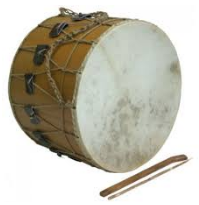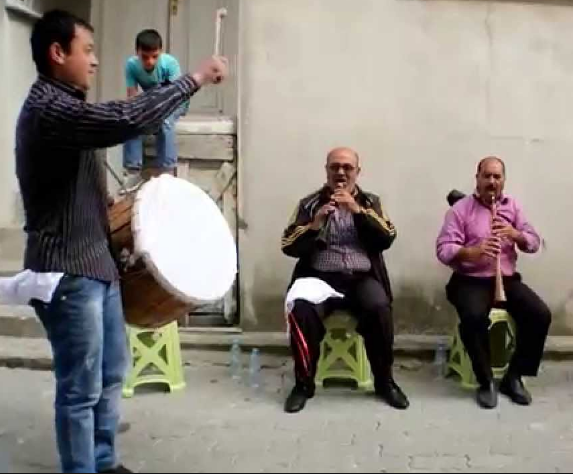


dauli (Greece), davul (Turkey), tupan (Bulgaria), tapan (Macedonia), lodra (Albania), dohol (Persia), dhol (Armenia), dahol (Kurdish), tobā (Romania), tabl (Arabic), etc
Text excerpts by Charles Keil from the HIGHLY RECOMMENDED “Bright Balkan Morning” by Charles and Angeliki Vellou Keil, 2002:
“The dauli (derived from davul, the name for the big drum in India) is a two-headed bass drum played on both sides; a big beater is used to thump one side, and a little stick is tapped on the other side or pressed against the skin to rattle whenever the opposite side is thumped.
The zurna (clearly the same word as sona in China or shalmai in India) is a shawm or outdoor oboe with a double reed – that is, a round reed is flattened and trimmed to form two vibrating elements, unlike the single reed of a saxophone or clarinet.


Double reeds are loud, penetrating, and hard to control, and they are capable of producing pitches, overtones, and sound effects that can’t be notated. A bass drum played on both sids at once often sounds like two drums: loud, buzzing, and clattering. Blended together, a dauli and two zurnas create complex “surround sounds” that are similar to double-reed and percussion ensembles found across Asia and circum-Saharan Africa (Dietrich 1983) and to the bagpipe and drum styles found across Europe and the British Isles, wherever the peopled landscape is still used for the enactment of rituals.”
Here’s double reeds and dauli – Pravo Oro by Ansambi Pece Atanasovski, FYR Macedonia
An Albanian example:
“The many Old World manifestations of this blown-and-beaten sound connect us to contemporary jazz and “world music.” They also connect people to something very old and to the sacred in each locality. From Scotland to Tibet, from Chechnya to Tiv land in Nigeria,

from Greece to Korea, crossing cultures, regions and continents, there is some kind of deeply rooted magic and mystery in double reeds and percussion. Something very old is carried in these sounds and in the dancing bodies,
the wrestling bodies,
and the processional bodies that these sounds inspire and support in Greek Macedonia.
Something both old and new may be in the sounds too, a way of celebrating differences across languages and cultures rather than fighting over them.”
“The zurna may be the most important instrument in the world – after the voice, of course, and after the drum or dauli… There is abundant evidence from antiquity demonstrating that paired pipes were used in ancient Egypt, and the double-reed instrument, called the aulos by the Greeks and usually played in pairs, was the central sound for carousing symposia as well as for rituals. The double aulos provided the accompaniment for the athletic contests dedicated to the gods, and it was closely associated with Dionysian rites in particular….”

“This paired-pipe tradition represented by bagpipes and zurnas is important not only because it seems to have been at the center of Greek traditions for over five thousand years, but because it is the instrument that penetrates to the core of Eastern cultures as well. Sona players with lots of percussion have supplied the sound for weddings, funerals and festivals in rural China ever since the Persians may have sent the instruments down the silk route. Can 800 million Han peasants be wrong about the sounds required for rites of passage?
In Tibetan tradition, a pair of double reeds and a pair of long bass trumpets are used by monks to bring up the sun each morning and put it behind the mountains every night. The double reeds are usually the most prominent pair of of the many pairs of instruments used in the monastery ensembles, to send the maximum number of vibrating overtones up into the spirit world….
Moving out in other directions from its ancient centers in Phrygia, Greece, Persia, and India, the double reeds have provided ceremonial music for ten centuries all over the Arab world… The 60 million Hausa people spread over seven west African nation-states know the double-reed instrument as alakeita, and it has diffused from Islamic African peoples around the rim of the Sahara to a number of peoples in the savanna…
I believe this is Morrocco
Outside Macedonia and the Balkans the sound of the paired double reed survives in Europe as Slavic and Celtic bagpipes. In addition to the Scotch and Irish, Bretons and Catalans keep the tradition going with their bombarde and graller…
Whether or not the Roma or Gypsies brought the instruments with them from India, whether or not they adapted the instruments to a preexisting centuries- or millennia-old style and contexts in Macedonia are all questions that may never be fully answered. What we do know is that in contemporary Greek Macedonia, the zurna and dauli – ta organa, the instruments – are called for on the occasion of weddings, saint’s day celebrations, and wrestling matches.”
Above, Ankara, Turkey. Below, Republic of Macedonia

